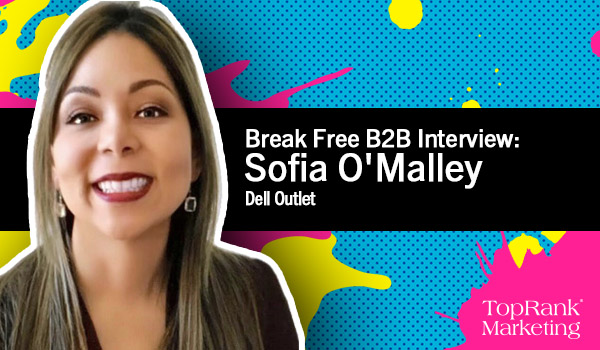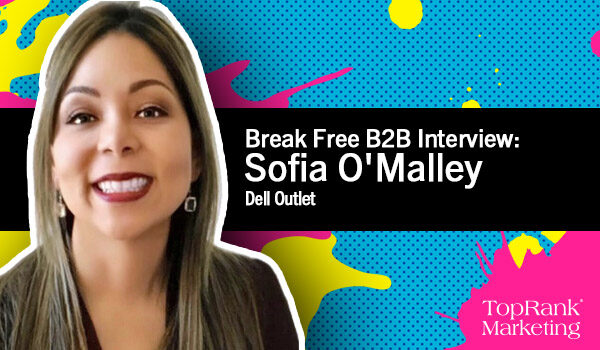
Okay, marketers, here’s your content marketing challenge for the day. Your target audience includes the following:
- Small business owners
- Gamers
- Teachers
- Lifestyle bloggers
- Young professionals/Entrepreneurs
All you have to do is come up with messaging that will resonate with each of these groups, while repurposing as much content as possible for maximum efficiency. Some of these segments are B2B, some are B2C, and some ride the line between the two, so plan accordingly.
Oh, and while you’re at it, we need versions of your content for multiple regions around the world. So make sure your Super Bowl metaphors are converted into World Cup references.
If you can get your head around this monumental task — well, you’re probably Sofia O’Malley, Global Marketing Director at Dell Outlet*. For the past three years, Sofia has worked with a team of talented marketers worldwide to turn Dell Outlet into a powerhouse brand.
We caught up with Sofia at B2BMX in February, at which Dell Outlet’s influencer content was a finalist for a Killer Content Award. The conversation covered everything from the difference between B2B and B2C messaging to the importance of purpose-driven marketing.
You can watch the full video and subscribe to the podcast below. Read on for highlights from the interview.
B2B Marketing Interview with Sofia O’Malley
1:06 From managing a cyber cafe to leading a global marketing team
2:33 Adapting messaging for B2B and B2C
4:00 Messaging and branding for refurbished electronics
7:00 Using technology to test and refine messaging
10:15 Marketing with a purpose
14:30 Adapting marketing for multiple geographic regions
18:00 How to structure global marketing teams
20:15 Mapping the customer journey to offer better customer experiences
24:36 New opportunities in digital marketing
27:00 Break Free: Going from good to great
Susan:
So okay, you manage a very unique product or service offering, I should say. And you have got two distinct audiences. You really are B2B as well as B2C. Can you talk about how you divide up your marketing programs?
Sofia:
You know, I think when you look at our customer base, there is a unifying element that is common across both subsets. And I think that’s the problem, right? It is a technology need, whether you’re a consumer or a big corporation or a small business, you have that underlying need that you want to have access to high quality technology, and you want to be able to go with a partner that you know will stand behind the offerings.
Susan:
Okay, great. Is there anything that you would counsel marketers on, who are trying to test their messaging?
Sofia
I will say we utilized some technology when it came to messaging, the high level message is still there and relevant, but when we do individual communication, we utilize certain technology to really offer more of a personalized message tailored to that party or curated to a particular audience at a given point in time.
One of the things that we have done that has been very successful is utilizing technology to overlay emotional messaging. That was really insightful because throughout the journey, we learned that there are people out there who are reward driven. So for example, instead of messaging you “Hey, Susan, come and take a look at my product.” I will maybe say something like “Hello Susan, come and reward yourself with a gaming system.” Because we have information that we know that maybe you like gaming and you’re a reward-driven person. So that has been super exciting. I know it’s not accessible to a lot of people, right? But I think that’s one of the areas that for me has worked really well. And we love to be able to do it.
Susan:
Okay, so even something as subtle for marketers who don’t have larger tools, even testing — AB testing one or two words — as you said, reward yourself is far different than, you know, come and check out the speeds and feeds.
Sofia:
Absolutely, it goes a long way into understanding like the audiences I think. It’s really important to have an understanding of who that consumer is. You know who your target is. Because in that way you’ll narrow it down, especially if you’re not using AI to do the heavy lifting. And if you don’t have the volumes to be able to conduct this kind of testing at scale, and see impact, I think if you’re on the smaller side, AB testing is the way to go. But you have to kind of help that process by really zeroing in on what audience is to be more effective.
Susan:
Right, what do you see as being the biggest difference in terms of global marketing? Is LATAM completely different than other regions, for example?
Sofia:
Well tricky question, because there are a lot of commonalities. But I think the key is really to have a consistent strategy. I think that needs to be scalable. And then where we start to see a little bit more difference is on the tactics.
So when you think about implementation of go to market, I think you really have to be cognizant of what is unique to each market. What’s the consumer behavior? Or what’s the consumer expectation within a given market or appetite for a type of execution.
So when I think, in Latin America, there are still challenges when it comes to maturity on the technology front. I think there is evolution and there is a lot more appetite for people too, more comfort level in people utilizing the internet for big ticket purchase items than there was maybe like 15-10 years ago. It continues to evolve. But I think still having that local presence and introduction in your creative and in your assets of local holidays or local events or big sporting events that might not necessarily be that big within the North American market.
For instance, in the US we’re all about our regular holidays like the Super Bowl, whereas Latin America is very passionate about soccer. So it’s a matter of balancing the tactics and being contextually relevant for the audience. But overarching, your message and your brand promise should be consistent.
Susan:
Okay, so for some of our viewers who are struggling with or even thinking about how to structure a global marketing team, can you talk about how you structure your team to actually address those contextually relevant needs?
Sofia:
Absolutely. So one key area that is super important is to be able to have in-region geographically-placed leaders ready for each of my regions. So for example, for the North American market, I need to have someone in the US, right? For Asia Pacific and Japan (APJ), I need to have someone in the APJ region to be able to effectively not only be co-located with our sales teams, but also be very much aware of the environment and the key nuances that are needed to effectively drive marketing in a region.
And I will say the other big element is the right partnerships, which I know might be challenging, especially if you’re on the smaller side, but we typically try to identify partnerships with local agencies or agencies that have local presence. Because of the same objectives, we want to make sure that we are having the best or most recent information that is impacting that market. And if you work with a centralized team outside of the region, that might be a challenge. So yeah, I will say when I looked at the structure, that’s key.
The other big factor for us is to still be able to drive economies of scale — and it’s a fine balance — it requires ongoing effort because you always want to drive efficiencies, right? So I’m always thinking about what kind of parts of the business will we scale and share, such as when it comes to content, when it comes to asset creation, when it comes to even older areas of the business which are more focused on the merchandising and execution. How will I utilize maybe an asset that was originally created for the US market, for instance, and scale it? Right. So there is always thought of that. But that doesn’t — and I don’t believe it will ever — replace having that regional expertise.
Stay tuned to the TopRank Marketing Blog and subscribe to our YouTube channel for more Break Free B2B interviews. Here’s a sample of the series so far:
- Break Free B2B Marketing: Julie Brown on Proving the EBIT of Your Marketing
- Break Free B2B Marketing: Mark Bornstein on Digital Experience
- Break Free B2B Marketing: Sruthi Kumar on Creating Memorable Experiences
- Break Free B2B Series: Hal Werner on the Intersection of Marketing Creativity and Analytics
- Break Free B2B Series: Adi Bachar-Reske on Taking the Lead in the Evolution of B2B Content Marketing
*Dell Outlet is a TopRank Marketing client.



